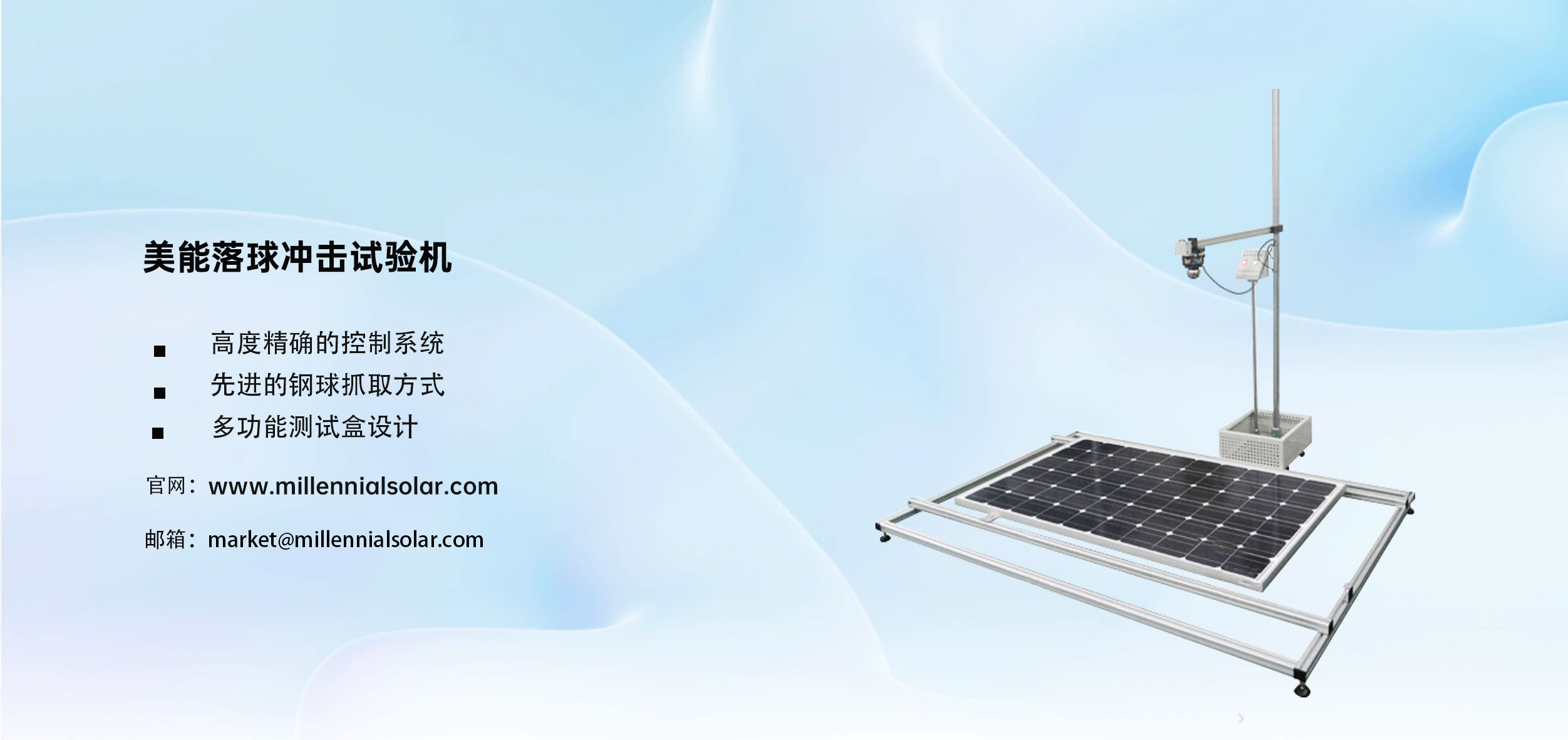
量子效率测试仪
PL/EL一体机
Sinton硅片少子寿命测试仪
Sinton硅块少子寿命测试仪
绒面反射率测试仪
3D共聚焦显微镜
清洗制绒工作站
在线四探针方阻测试仪
全自动扫描四探针方阻测试仪
在线薄膜厚度测试仪
晶化率测试仪
Horiba显微共焦拉曼光谱仪
傅里叶红外光谱仪
霍尔效应测试仪
分光光度计
全光谱椭偏仪
Horiba椭圆偏振光谱仪
TLM接触电阻率测试仪
超景深显微镜
网版智能影像测量仪
全自动影像测量仪
卧式拉力机
电池片稳态光衰老化试验箱
电池片紫外老化试验箱
电池片拉脱力综合测试仪
外观检验台
湿漏电测试系统
组件实验室EL测试仪
紫外老化试验箱
稳态光衰老化试验箱
电流连续性监测系统
PID测试系统
旁路二极管测试系统
LeTID测试系统
反向电流过载系统
脉冲电压测试系统
绝缘耐压测试仪
接地连续性测试仪
绝缘耐压接地测试仪
湿热环境试验箱
湿冻环境试验箱
热循环试验箱
动态机械载荷测试机
静态机械载荷测试机
冰雹冲击试验机
引出端强度试验机
霰弹冲击试验机
抗划伤(切割)测试机
剥离试验机
万能材料试验机(单臂)
万能材料试验机(双臂)
光伏玻璃透过率测试仪
醋酸测试试验箱
交联度测试系统
二极管接线盒综合测试仪
落球冲击试验机
半自动四探针
全自动探针式台阶仪
多通道太阳能MPPT系统
Horiba稳瞬态荧光光谱仪
钙钛矿P1激光划线测试仪
钙钛矿在线膜厚测试仪
钙钛矿工艺检测工作站
手持式IV测试仪
便携式EL测试仪
手持热成像测试仪
户外组件IV测试仪
户外组件多通道测试系统
光伏逆变器电能质量测试仪
无人机EL检测仪
美能落球冲击试验机:高精度抗冲击性能评估设备解析
日期:2024-07-15浏览量:20
在现代工业应用中,抗冲击性能是确保产品可靠性和安全性的关键因素,尤其是在光伏组件、钢化玻璃和接线盒领域。美能落球冲击试验机,专为检测这些材料的抗冲击性能而设计。该设备符合UL 1703、JIS-K6745和A5430国际标准,通过高精度的直流电磁控制系统和多种钢球重量选择,能够精确模拟实际冲击情况,提供可靠的测试结果。本文将深入探讨美能落球冲击试验机的基本原理、技术规格以及其在品质检测中的重要作用,展示其在提升产品质量和安全性方面的卓越性能。

基于落球冲击试验的基本原理
落球冲击试验是一种用于评估材料在受到突然冲击时的力学性能和耐久性的实验方法。该试验通过将一定质量的球体从特定高度自由落下,撞击在被测试的材料表面,从而模拟实际应用中可能遇到的冲击情况。通过分析球体对材料的冲击力、材料的变形、损伤以及恢复能力等,可以评估材料的抗冲击性能。

不同冲击次数破损形态记录
冲击力的测量:通过安装在试样上的传感器(如压力传感器)记录落球冲击过程中产生的冲击载荷时程曲线,进而计算出位移时程曲线和能量时程曲线。这些数据有助于了解材料在受到冲击时的动态响应和能量吸收能力。
材料损伤的观察与分析:落球冲击会导致组件表面或内部产生裂纹、变形或其他形式的损伤。通过对这些损伤形态的观察和分析,可以评估材料的抗裂性和断裂韧性。
多次冲击的影响:对于某些材料,如光伏组件,多次落球冲击可能会导致累积损伤,表现为载荷峰值减小、回弹速度变小和吸收能增大。这种累积效应是评估光伏组件长期耐久性的重要指标。
落球冲击试验是一种重要的材料性能测试方法,它通过模拟实际应用中的冲击条件,评估材料的抗冲击性、改进光伏电池组件的性能。
基于落球冲击试验的目的
落球冲击试验是将规定质量的钢球从不同高度落下或在规定高度下将不同质量的钢球落下 , 以测定试样在承受落球冲击下发生破碎失效所需的能量。
为了确保获得的数值计算结果是可靠的 ,实验首先需要验证建立的有限元模型。在无残余应力条件下,模拟真实落球冲击试验的两个临界高度 46. 5 和 251. 5 mm (落球冲击后样片全部完整和全部破碎时对应的落球高度 )下的落球冲击强度。
数值计算结果表明, 当落球高度为46. 5 mm 时基板玻璃保持完整 ,而当落球高度为251. 5 mm 时基板玻璃发生破碎失效, 同时破碎形貌与真实试验相符 ,两条交叉的主要裂纹从受冲击区域向外拓展。

试验和模拟中的基板玻璃破碎形貌
美能落球冲击试验机是一款针对检测组件、钢化玻璃及接线盒质量风险的高精度设备,完全符合UL 1703、JIS-K6745和A5430等国际标准严格要求。该设备利用规定重量的钢球从可调高度(0-2000mm)自由落下,打击试件,观察其受损程度,从而预先确定材料和产品的抗冲击性能。其采用直流电磁控制方式,确保钢球释放的精确性和稳定性。
美能落球冲击试验机
美能落球冲击试验机ME-PV-FBI-2000专为检测组件、钢化玻璃及接线盒质量波动而设计,符合UL 1703、JIS-K6745和A5430标准。

直流电磁控制系统保证钢球释放的精确性
多种钢材重量适应不同的材料和产品需求
220V/50Hz电源配置,保证设备在各类评估中的稳定运行
美能落球冲击试验机ME-PV-FBI-2000以其高精度和稳定性,成为评估光伏组件、钢化玻璃和接线盒抗冲击性能的理想工具。符合UL 1703、JIS-K6745和A5430标准,该设备通过直流电磁控制系统确保钢球释放精确,并在220V/50Hz电源配置下稳定运行。美能落球冲击试验机不仅提升产品质量,还为材料性能改进提供关键数据支持,是品质检测的最佳选择。




































































